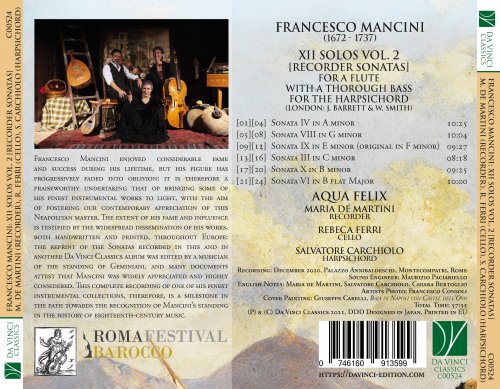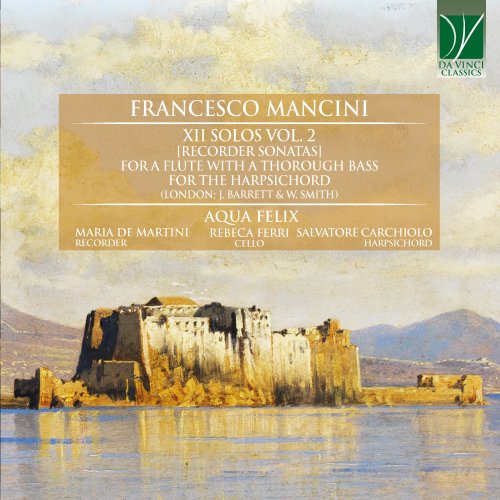
Maria De Martini, Salvatore Carchiolo, Rebeca Ferri, AQUA FELIX - Francesco Mancini: XII Solos Vol. 2 (Recorder Sonatas) for a Flute with a Thorough Bass for the Harpsicord (London: J. Barrett & W. Smith) (2022)
BAND/ARTIST: Maria De Martini, Salvatore Carchiolo, Rebeca Ferri, AQUA FELIX
- Title: Francesco Mancini: XII Solos Vol. 2 (Recorder Sonatas) for a Flute with a Thorough Bass for the Harpsicord (London: J. Barrett & W. Smith)
- Year Of Release: 2022
- Label: Da Vinci Classics
- Genre: Classical Piano
- Quality: flac lossless (tracks)
- Total Time: 00:57:39
- Total Size: 283 mb
- WebSite: Album Preview
Tracklist
01. Sonata IV in A Minor: I. Spiritoso-Largo
02. Sonata IV in A Minor: II. Allegro
03. Sonata IV in A Minor: III. Largo
04. Sonata IV in A Minor: IV. Allegro spiccato
05. Sonata, vol. III in G Minor: I. Largo
06. Sonata, vol. III in G Minor: II. Allegro
07. Sonata, vol. III in G Minor: III.
08. Sonata, vol. III in G Minor: IV. Allegro
09. Sonata IX in E Minor: I.
10. Sonata IX in E Minor: II. Allegro
11. Sonata IX in E Minor: III. Largo
12. Sonata IX in E Minor: IV. Allegro
13. Sonata III in C Minor: I. Largo affettuoso
14. Sonata III in C Minor: II. Allegro
15. Sonata III in C Minor: III. Largo
16. Sonata III in C Minor: IV. Allegro
17. Sonata X in B Minor: I. Largo
18. Sonata X in B Minor: II. Allegro
19. Sonata X in B Minor: III. Largo
20. Sonata X in B Minor: IV. Allegro
21. Sonata, vol. I in B-Flat Major: I. Largo
22. Sonata, vol. I in B-Flat Major: II. Allegro
23. Sonata, vol. I in B-Flat Major: III. Largo
24. Sonata, vol. I in B-Flat Major: IV. Allegro

Francesco Mancini enjoyed considerable fame and success during his lifetime, but his figure has progressively faded into oblivion; it is therefore a praiseworthy undertaking that of bringing some of his finest instrumental works to light, with the aim of fostering our contemporary appreciation of this Neapolitan master.
Born in 1672, he was the son of Nicola, an organist, to whom probably the first musical education of Francesco is to be ascribed. Following the premature death of his father, Francesco continued his musical studies at one of the best-known Conservatories of the city of Naples, that of the Pietà dei Turchini. Upon completing his education there, and having served for six years as an organist at the same institution, Mancini embarked on a successful career as a court musician.
Towards the end of the century, he had already established himself as an appreciated composer, particularly in the field of vocal music, where he was to become one of the main figures of the Neapolitan panorama. His oratories, unfortunately largely lost, were performed throughout the Peninsula; his operas followed each other regularly in the first decade of the eighteenth century.
At the same time, Mancini nourished high hopes to obtain the much-desired appointment as Chapel Master in the court orchestra. The propitious opportunity seemed to come in July 1707, when two unforeseen circumstances appeared to favour the composer. During a leave of the titular, Alessandro Scarlatti, Naples fell under Austrian jurisdiction, and a viceroy took office. Sparing no efforts, Mancini composed a festive Te Deum celebrating the new rulers and thus positioning himself in the most favourable light. The expected results came soon, and Mancini obtained the appointment; however, approximately one and a half year later, Scarlatti reacted to the usurpation and was reinstalled in his previous role. In spite of this, the whole enterprise had actually brought some lasting improvements in Mancini’s career, and had consolidated his status as the designated successor of Scarlatti.
In the following years, Mancini kept writing successful operas, some of which were premiered in Rome, a city he regularly visited. He was also gifted with a comical vein, which counterbalances the earnestness of his opera serie and oratorios. His pedagogical activity was also fundamental for the education of younger musicians, and was acknowledged publicly with important appointments. Moreover, Mancini established lasting relationships with the numerous confraternities of the city, participating as a composer and musician in their festivities and celebrations. His overall production bears witness to his multifaceted talent, which expressed itself in almost all genres practised by the composers of his era. His predilection for vocality, however, emerges clearly also in his instrumental music, characterized by beautiful cantabile lines and sustained melodies.
In 1725, at Scarlatti’s death, Mancini obtained the role of Chapel Master, for which he had so actively fought. Nine years later, however, another political earthquake hit the city: the Austrians lost Naples to the Bourbons. Demonstrating uncommon political ability, Mancini was capable of maintaining his status and privileges under the new rulers, whom he greeted, once more, with a festive Te Deum. Unfortunately, however, he was able to fulfill his duties as a Chapel Master only for one more year, since in 1735 he lost all of his faculties and remained paralysed for the following two years, until his death in 1737.
The extent of his fame and influence is testified by the widespread dissemination of his works, both handwritten and printed, throughout Europe: the reprint of the Sonatas recorded in this and in another Da Vinci Classics album was edited by a musician of the standing of Geminiani, and many documents attest that Mancini was widely appreciated and highly considered.
This complete recording of one of his finest instrumental collections, therefore, is a milestone in the path towards the recognition of Mancini’s standing in the history of eighteenth-century music.
01. Sonata IV in A Minor: I. Spiritoso-Largo
02. Sonata IV in A Minor: II. Allegro
03. Sonata IV in A Minor: III. Largo
04. Sonata IV in A Minor: IV. Allegro spiccato
05. Sonata, vol. III in G Minor: I. Largo
06. Sonata, vol. III in G Minor: II. Allegro
07. Sonata, vol. III in G Minor: III.
08. Sonata, vol. III in G Minor: IV. Allegro
09. Sonata IX in E Minor: I.
10. Sonata IX in E Minor: II. Allegro
11. Sonata IX in E Minor: III. Largo
12. Sonata IX in E Minor: IV. Allegro
13. Sonata III in C Minor: I. Largo affettuoso
14. Sonata III in C Minor: II. Allegro
15. Sonata III in C Minor: III. Largo
16. Sonata III in C Minor: IV. Allegro
17. Sonata X in B Minor: I. Largo
18. Sonata X in B Minor: II. Allegro
19. Sonata X in B Minor: III. Largo
20. Sonata X in B Minor: IV. Allegro
21. Sonata, vol. I in B-Flat Major: I. Largo
22. Sonata, vol. I in B-Flat Major: II. Allegro
23. Sonata, vol. I in B-Flat Major: III. Largo
24. Sonata, vol. I in B-Flat Major: IV. Allegro

Francesco Mancini enjoyed considerable fame and success during his lifetime, but his figure has progressively faded into oblivion; it is therefore a praiseworthy undertaking that of bringing some of his finest instrumental works to light, with the aim of fostering our contemporary appreciation of this Neapolitan master.
Born in 1672, he was the son of Nicola, an organist, to whom probably the first musical education of Francesco is to be ascribed. Following the premature death of his father, Francesco continued his musical studies at one of the best-known Conservatories of the city of Naples, that of the Pietà dei Turchini. Upon completing his education there, and having served for six years as an organist at the same institution, Mancini embarked on a successful career as a court musician.
Towards the end of the century, he had already established himself as an appreciated composer, particularly in the field of vocal music, where he was to become one of the main figures of the Neapolitan panorama. His oratories, unfortunately largely lost, were performed throughout the Peninsula; his operas followed each other regularly in the first decade of the eighteenth century.
At the same time, Mancini nourished high hopes to obtain the much-desired appointment as Chapel Master in the court orchestra. The propitious opportunity seemed to come in July 1707, when two unforeseen circumstances appeared to favour the composer. During a leave of the titular, Alessandro Scarlatti, Naples fell under Austrian jurisdiction, and a viceroy took office. Sparing no efforts, Mancini composed a festive Te Deum celebrating the new rulers and thus positioning himself in the most favourable light. The expected results came soon, and Mancini obtained the appointment; however, approximately one and a half year later, Scarlatti reacted to the usurpation and was reinstalled in his previous role. In spite of this, the whole enterprise had actually brought some lasting improvements in Mancini’s career, and had consolidated his status as the designated successor of Scarlatti.
In the following years, Mancini kept writing successful operas, some of which were premiered in Rome, a city he regularly visited. He was also gifted with a comical vein, which counterbalances the earnestness of his opera serie and oratorios. His pedagogical activity was also fundamental for the education of younger musicians, and was acknowledged publicly with important appointments. Moreover, Mancini established lasting relationships with the numerous confraternities of the city, participating as a composer and musician in their festivities and celebrations. His overall production bears witness to his multifaceted talent, which expressed itself in almost all genres practised by the composers of his era. His predilection for vocality, however, emerges clearly also in his instrumental music, characterized by beautiful cantabile lines and sustained melodies.
In 1725, at Scarlatti’s death, Mancini obtained the role of Chapel Master, for which he had so actively fought. Nine years later, however, another political earthquake hit the city: the Austrians lost Naples to the Bourbons. Demonstrating uncommon political ability, Mancini was capable of maintaining his status and privileges under the new rulers, whom he greeted, once more, with a festive Te Deum. Unfortunately, however, he was able to fulfill his duties as a Chapel Master only for one more year, since in 1735 he lost all of his faculties and remained paralysed for the following two years, until his death in 1737.
The extent of his fame and influence is testified by the widespread dissemination of his works, both handwritten and printed, throughout Europe: the reprint of the Sonatas recorded in this and in another Da Vinci Classics album was edited by a musician of the standing of Geminiani, and many documents attest that Mancini was widely appreciated and highly considered.
This complete recording of one of his finest instrumental collections, therefore, is a milestone in the path towards the recognition of Mancini’s standing in the history of eighteenth-century music.
Year 2022 | Classical | FLAC / APE
As a ISRA.CLOUD's PREMIUM member you will have the following benefits:
- Unlimited high speed downloads
- Download directly without waiting time
- Unlimited parallel downloads
- Support for download accelerators
- No advertising
- Resume broken downloads


